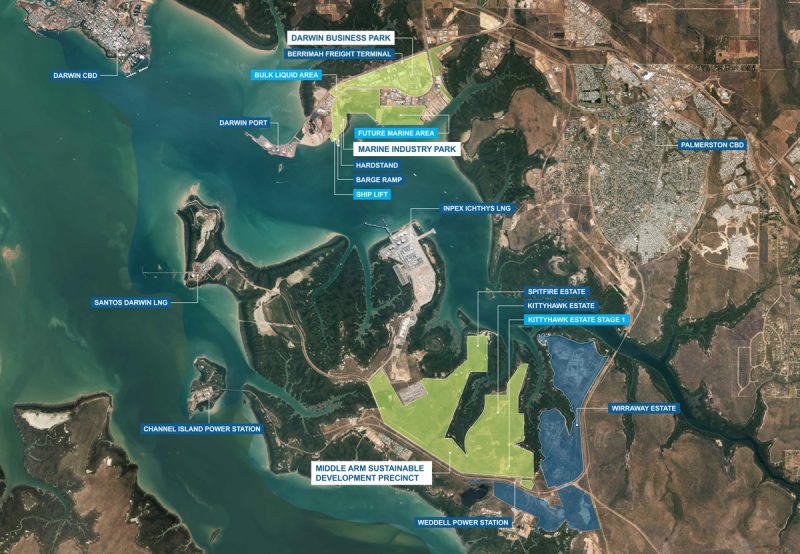
Land allocation
The Middle Arm Sustainable Development Precinct is a central site that will see existing industry grow through decarbonisation technologies, sustainable new manufacturing sectors established and world-leading transformations in how energy is produced, transported and consumed.

A master-planned approach
Master planning ensures the Precinct integrates projects aligned for success in today’s transitioning low-emissions sectors, while simultaneously planning, developing and implementing readiness for emerging projects that will thrive in our future net zero emissions environment.
The precinct has attracted significant interest across a range of proponents, projects and industry sectors and the Northern Territory Government is working to ensure a strategic approach to project development that optimises efficiency, lowers investment risk and supports a streamlined approach to decision making.
In allocating land in the Precinct, the master-planned approach will consider circular economy benefits for Precinct occupants, as well as fostering strong and sustainable environmental, economic, social, cultural and governance (EESCG) objectives.
Land allocation
A Land Allocation Framework has been developed to ensure strategic land allocation alignment with the sustainable precinct plan.
The framework will lead robust evaluations considering the strategic and economic benefits anticipated and contributions to maximising integration and collaboration.
While individual project proposals will be subject to continued commercial development, the Land Allocation Framework will offer proponents certainty of the land requirement to facilitate project planning.
Projects will still need to apply for approvals, consult with the community and address all regulatory and administrative requirements of the Environment Protection Authority.
Below is a breakdown of the 4 stages of the process:
- INITIAL PROPONENT INTEREST
Initial discussions with a proponent to understand the proposed project and to facilitate preliminary discussions on potential site optionality. - DUE DILIGENCE
Further and more detailed consideration of the key project requirements occurs.
Once sufficient detail is understood, LDC will share a proponent project proposal (PPP) proforma for proponent submission. - ASSESSMENT AND APPROVAL PATHWAY
Upon receipt of a suitable PPP document and completion of a due diligence process, a review and assessment commences to evaluate a proponent’s project suitability.
Following assessment, the land allocation proposal progresses through the approval pathway. - SITE ALLOCATION
Depending on the outcome of the land allocation assessment and approvals, LDC may engage with the proponent to formalise a tenure pathway and allocation.
What does the framework consider?
The Framework evaluates proposed project and land requests upon the strategic and economic benefits expected, with detailed consideration of:
- compatibility and consistency with the precinct’s strategic objectives
- actual need and clear justification for integration within the precinct
- need for location near particular services, infrastructure and resultant synergies with neighbouring industry with a circular economy approach
- proponent’s demonstrated industry experience, financial capacity and capability to deliver (and continue to operate) the project
- alignment with Territory Government objectives and priority sectors
- benefits to the Territory economy (for example, jobs, expenditure and other opportunities)
- commercial viability.
More information
For more detailed information on the process download the brochure below.
Enquiries
For more information about the land allocation process and to discuss your interest in the precinct, please contact:

Hannah Barraza
Business Director
Phone: 08 8944 0909
Mobile: 0421 676 165
Email: hannah.barraza@landdevcorp.com.au
